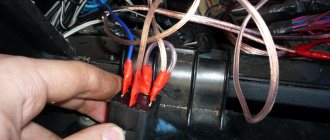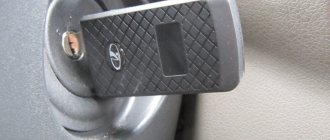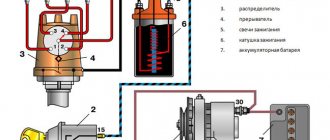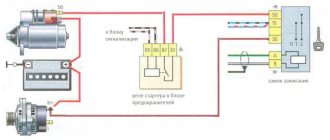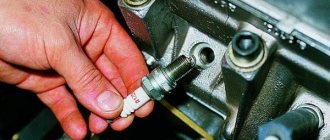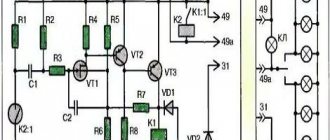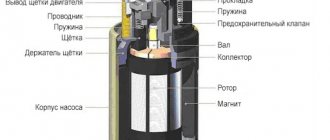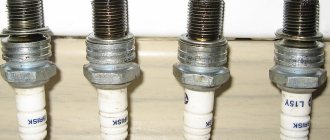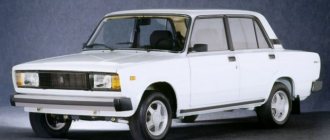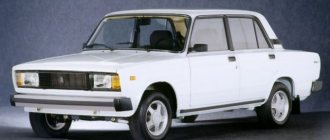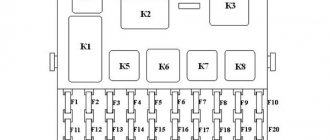Small and inconspicuous parts of the car are almost always ignored by drivers, because the chassis or the engine itself seem more important and require special care. However, big problems with the car most often arise due to some “little thing” - for example, the ignition relay. This is a miniature device that plays a very important role on the VAZ 2107.
- Principle of operation
- Relay location in the car
Table: designations of relays and fuses
- How to check the ignition relay on the "seven"
Video: checking the relay yourself
- Photo: main stages of work
Ignition relay VAZ 2107
The very first versions of the VAZ did not have a fuse and relay block, that is, power was supplied to the coil through the ignition switch itself. Such a motor starting system “ate up” a lot of electricity, and the contacts quickly oxidized and stopped functioning normally.
The VAZ 2107 is equipped with a modern ignition relay. Its main function is to reduce the load on the contacts when turning on the device, since the relay turns off some electrical circuits at the moment of startup. The ignition relay is used in both carburetor and injection VAZ 2107 models.
The miniature device reduces the load on the contacts, which extends the service life of all ignition elements
Principle of operation
The ignition relay is one of the elements of the entire ignition system. This system consists of:
- spark plugs;
- distributor;
- capacitor;
- breaker cam;
- coils;
- mounting block;
- switch.
When the engine starts, power from the spark plugs goes to the ignition relay, which switches energy from some circuits. Thanks to this, the coil is supplied with the amount of power that is necessary to start the engine normally. To ensure uniform current supply, the relay works directly with the distributor and capacitor.
Relay location in the car
Any problems with the ignition relay on a VAZ 2107 begin with the fact that the driver cannot start the engine the first time. Suspicions immediately arise regarding the performance of certain components, but, as a rule, the relay is the first thing to be checked. On the “seven” it is located immediately behind the instrument panel and is fixed under the dashboard. This arrangement cannot be called convenient, because to get to the relay, you will need to remove the entire dashboard.
The ignition relay is located in a common block directly behind the instrument panel in the cabin
Table: designations of relays and fuses
| Fuse number (rated current)* | Purpose of VAZ 2107 fuses |
| F1 (8A/10A) | Rear lights (reversing light). Reverse safety device. Heater electric motor. Heater fuse. Warning lamp and heated rear window relay (winding). Electric motor for rear window cleaner and washer (VAZ-21047). |
| F2 (8/10A) | Electric motors for wipers, windshield washers and headlights. Relay for wipers, windshield washers and headlights (contacts). Wiper fuse for VAZ 2107. |
| F3/4 (8A/10A) | Reserve. |
| F5 (16A/20A) | Rear window heating element and its relay (contacts). |
| F6 (8A/10A) | Cigarette lighter fuse for VAZ 2107. Socket for a portable lamp. |
| F7 (16A/20A) | Sound signal. Radiator cooling fan electric motor. Fan fuse for VAZ 2107. |
| F8 (8A/10A) | Direction indicators in hazard warning mode. Switch and relay-interrupter for direction indicators and hazard warning lights (in hazard warning mode). |
| F9 (8A/10A) | Fog lights. Generator voltage regulator G-222 (for some vehicles). |
| F10 (8A/10A) | Instrument cluster. Instrument panel fuse. Indicator lamp and battery charge relay. Direction indicators and corresponding warning lamps. Indicator lamps for fuel reserve, oil pressure, parking brake and brake fluid level. Voltmeter. Instruments of the carburetor electro-pneumatic valve control system. Parking brake warning light relay. |
| F11 (8A/10A) | Brake light bulbs. Lamps for interior body lighting. Brake light fuse. |
| F12 (8A/10A) | High beam (right headlight). Winding for switching on the headlight cleaner relay. |
| F13 (8A/10A) | High beam (left headlight) and high beam indicator lamp. |
| F14 (8A/10A) | Side light (left headlight and right rear light). Indicator lamp for turning on the side light. License plate lights. Engine compartment lamp. |
| F15 (8A/10A) | Side light (right headlight and left rear light). Instrument lighting lamp. Cigarette lighter lamp. Glove box lighting lamp. |
| F16 (8A/10A) | Low beam (right headlight). Headlight cleaner relay activation coil. |
| F17 (8A/10A) | Low beam (left headlight). |
| * In the denominator for pin type fuses | |
More information about the electrical equipment of the VAZ 2107: https://bumper.guru/klassicheskie-modeli-vaz/elektrooborudovanie/elektroshema-vaz-2107.html
Types of relays used on the VAZ 2107:
- Relays and pin-type fuses located in the mounting block.
- Relay for turning on the heated rear window.
- Relay for turning on headlight cleaners and washers.
- Relay for turning on sound signals (jumper installed).
- Cooling system fan motor activation relay (not used since 2000).
- Headlight high beam relay.
- Relay for low beam headlights.
The VAZ 2107 uses only 7 main relays
The driver needs to know that the ignition relay on all VAZ 2107 models is installed next to the emergency power relay. Both devices have the same potential, so in case of breakdowns on the road, an emergency relay can be installed in place of the burnt-out ignition relay.
The ignition relay and emergency power relay have the same structure and potential, therefore they are considered interchangeable
Is the relay the same in carburetor and injection models?
VAZ 2107 has a very long development history. Today, all existing models can be divided into two types: old and new. Both carburetor and injection VAZ 2107 use exactly the same ignition relays, but you should carefully select a new relay based on the year of manufacture of the car.
Any type of power unit can be equipped with an old-style ignition relay, that is, the device can be considered universal. However, the new model relays are suitable exclusively for “sevens” after 2000.
The old unit uses relays of different sizes and shapes, the new ones use standard parts with increased performance
Design and principle of operation of the lock assembly
On a VAZ 2109 car, 2 standard modifications of the lock can be installed. The old one has catalog number 21080-3704005-60. It features four key positions (long), and also contains an ignition relay. The new unit with catalog number 21080-3704005-30 has only three key positions and does not have a relay.
To connect all the wires to the VAZ 2109 car lock, a contact group is used. Each of the key positions has its own blocking, and therefore consumer groups.
Contacts “30” and “30/1” are closed. All dependent power circuits are disabled.
In this position, voltage is supplied to the elements of the ignition control system. To do this, the white and brown wires are connected, and the pink wire is connected to black and blue. In this case, several groups of contacts are formed. For example, “30 INT” turns on the power supply circuit for external lighting, including high beam lighting, and the dashboard lighting. Contacts “30/1” and “15/1” provide voltage to the direction indicator lamps, reverse lights, elements of the ignition system, etc. The pair “30/1”, “15/2” powers the low/high beam headlights, fog lights , washer, fans.
The ignition relay, which was switched on in the previous step, continues to operate. The main one is a pair of contacts “30”, “50”, which provides voltage for the starter to operate. In parallel to it, circuits should be formed from contact connections “30/1”, “15/1”, as well as “30/1”, “15/2”. The consumers that are connected in this case are similar to those described for position “I”. The pink wire in the contact pair, together with the black one, is shorted to red (instead of blue).
Used to supply voltage to the components of the parking (“30/1 P”) and side lighting/dashboard lighting (“30 INT”) components. The black wire forms a closed circuit with the brown and pink wires.
The lock and its circuit perform two functions: electrical and mechanical. The essence of the first is to close certain groups of contacts based on the position of the key. From a mechanical point of view, when the ignition is turned off, the steering wheel is blocked, making it impossible to rotate. That is, the second function is protective.
How to check the ignition relay on the "seven"
You can check the ignition relay directly on the car, so you can carry out this procedure yourself in two to three minutes. However, for accuracy of work, it is recommended to arm yourself with a multimeter or at least a regular indicator light. Next, you need to proceed according to the following algorithm:
- Remove the connected block from the relay.
- Inspect the contacts for oxidation, damage and contamination.
- If necessary, you need to clean the contacts.
- Connect a multimeter to the relay contacts.
After applying power to the relay, it is necessary to measure the voltage that the device produces. If there is no short circuit when current is applied to terminals 85 and 86, then the relay is faulty. The functionality of the relay is determined by the closure of the contacts between pins 30 and 87. The numbering of the terminals is indicated on the relay itself on the reverse side.
Read about the contactless ignition system: https://bumper.guru/klassicheskie-modeli-vaz/elektrooborudovanie/zazhiganie/zazhiganie-2107/elektronnoe-zazhiganie-na-vaz-2107.html
Video: checking the relay yourself
https://youtube.com/watch?v=xsfHisPBVHU
How to check the serviceability/failure of the ignition switch of the “nine”?
The ignition switch, like any other element of the car, can fail. In such a situation, it is necessary to either repair the ignition switch or, in case of a serious malfunction, simply replace this element with a new one. However, in the latter case, before carrying out this very replacement, you should make sure that the ignition switch is actually faulty. How to do it?
The ignition key must be inserted into the ignition switch and this key must be installed in a certain position. During such actions, the circuit must be closed, which is used to judge the functionality of the lock. For example, when the ignition key is turned to the third position, the security system should begin to operate, and when the key is turned to the zero position, this system should turn off. Any deviations here will indicate actual problems with the ignition.
Another way to check the lock's functionality is to turn the steering wheel. It shouldn't be blocked. The lock should only operate when the ignition key is turned a second time from the first position to the second. And the key, as you know, can only be turned to the second position from the zero position.
Replacing the ignition relay on a VAZ 2107
To replace the ignition relay yourself, you do not need any special tools. You can easily get by with the devices that any driver has in their kit:
- a screwdriver with a straight and thin blade;
- screwdriver with a Phillips blade;
- 10mm wrench.
Using ordinary screwdrivers you can remove the ignition relay in a few minutes
If the relay stops working, it is impossible to restore it, since the original design of this part does not imply repair work. Therefore, if there are problems with the relay, you can only replace it with a new one.
Having reached the burnt-out relay, all that remains is to pull it out and install a new one in its regular place
The operating procedure for both injection and carburetor VAZ 2107 models will be the same. To create safe conditions during replacement, it is recommended to remove the negative cable from the machine’s battery before starting work. Then proceed according to the scheme:
- Start removing the instrument panel by unclamping the fasteners with a screwdriver.
- Remove the handles from the levers that hold the shield.
- Pull out the air duct nozzles by prying each of them with a screwdriver blade.
- Immediately after the nozzles, pull towards you and pull out the heater mode switch, having first disconnected the wires from it.
- Next, remove the line ends from this switch.
- Using a screwdriver, pull out the screw and its plug.
- Using a size 10 wrench, unscrew the nut securing the car's mileage reset handle.
- Push the handle as far into the dashboard as possible.
- Then remove the right edge of the shield.
- Disconnect the nut that secures the car's speedometer drive cable.
- Remove the hose from the fitting.
- Remove the wire blocks that go to the panel.
- After all this work, you can remove the instrument panel.
- The ignition relay is located immediately behind it, on a special bracket. Using a 10mm wrench, unscrew the fixing nut and remove the relay.
- Install a new one in place of the failed device, performing installation work in the reverse order.
If you installed it yourself
The previous owner of the car, in the absence of such a standard part, could install it himself. Such installation kits are sold in car dealerships. In this case, the electric relay can be located not only in the “standard” location. Finding it without calling the previous owner will not be so easy.
If a breakdown of this part occurs on the way, then you can start the car by closing contacts 87 and 30 (the location and circuit diagram are printed on the top of the relay housing). In this case, you are allowed to use the machine without any restrictions. But at the first opportunity, be sure to fix the breakdown. The operation of the VAZ-2115 ignition system directly depends on the relay.
